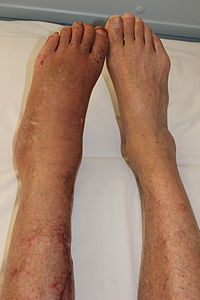
Photo from wikipedia
Background and Purpose Pain is one of the most common symptoms in patients after stroke. It is a distressing experience that affects patients’ quality of life, and it is highly… Click to show full abstract
Background and Purpose Pain is one of the most common symptoms in patients after stroke. It is a distressing experience that affects patients’ quality of life, and it is highly prevalent in clinical practice. The pathogenesis mechanisms of PSP are not so clear, and there is currently a lack of effective medical treatments, hence it is necessary to establish a sufficient understanding of this disease. Limited number of studies have applied bibliometric methods to systematically analyze studies on post-stroke pain. This study aimed to systematically analyze scientific studies conducted worldwide on post-stroke pain from 2012 to 2021 to evaluate global trends in this field using a bibliometric analysis. Methods Publications related to post-stroke pain from 2012 to 2021 were obtained from the Web of Science Core Collection database. Bibliometrics Biblioshiny R-package software was used to analyze the relationship of publication year with country, institution, journals, authors, and keywords and to generate variant visual maps to show annual publications, most relevant countries, authors, sources, keywords, and top-cited articles. Results In this study, 5484 papers met the inclusion criteria. The annual growth rate of publications was 5.13%. The USA had the highest number of publications (1381, 25.2%) and citations (36,395), and the University of Toronto had the highest number of papers (156, 2.8%). “Stroke”, “management”, “pain”, “risk”, “prevalence”, “ischemic stroke”, “risk factors”, “disease”, “diagnosis” and “therapy” are the top 10 keywords. Conclusion The global research interest regarding PSP has maintained growing over the past ten years. Both central post stroke pain and hemiplegic shoulder pain are the hottest research subjects. Further investigations are needed in order to reveal the mystery of the pathophysiologic mechanisms of CPSP, and high-quality well-designed trials of potential treatments of CPSP and HSP are also needed.
Journal Title: Journal of Pain Research
Year Published: 2023
Link to full text (if available)
Share on Social Media: Sign Up to like & get
recommendations!